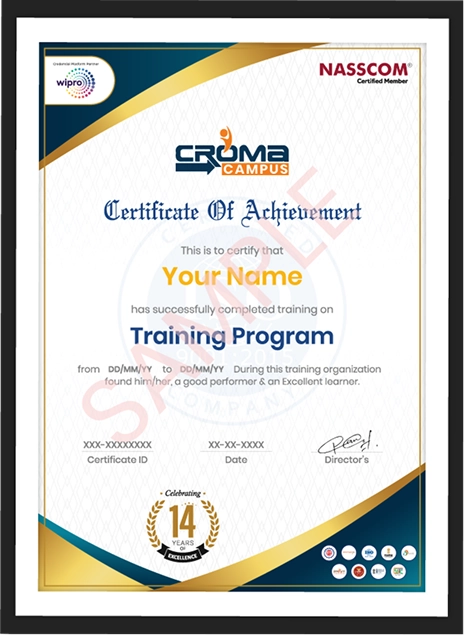Course Design By
Nasscom & Wipro
Make easy-to-use website pages
Build strong backend systems using Java
Use databases to store and manage data
Put your apps online using cloud tools
Frontend: What users see (like buttons, menus, and forms)
Backend: How the app works behind the scenes
Database: Where the app stores data
Product pages
Shopping carts
Payment systems
Inventory tracking
HR systems (to manage employees)
Customer support tools
Finance and billing software
Create APIs (ways apps talk to the server)
Manage user data
Make sure the app runs smoothly
Easy to scale (work for 10 or 10,000 users)
Always available
Safe and fast
Frontend: HTML, CSS, JavaScript, and popular tools like React or Angular (for what users see)
Backend: Java, Spring Boot, and Spring MVC (for how the app works behind the scenes)
Databases: MySQL and MongoDB (for saving data)
Having practice of some of the things can help you learn better. Well, you can read or watch the videos and build the apps step by step. This course also includes practical lab sessions where you can get real experience. This can help you to become more confident as well as prepared for the job.
You can work on the projects that should be based on the real business problems. Taking these projects can help you understand how companies may work and prepare you for the interviews. These projects can add a credential to your portfolio.
The teachers are experienced professionals who have worked on real Java Full Stack projects. They know what skills companies look for and share real tips from the industry.
There are many courses available at the current time that can suit your schedule. You can choose different timings that can be morning, evening, or weekend classes. Because many institutions nowadays offer online or hybrid options, you can learn from home if needed.
Eclipse / IntelliJ IDEA (for coding)
Git (for version control)
Maven (for building projects)
Testing tools (to check your code)
Resume-building help
Mock interviews
Job placement support
Direct connections with companies hiring in Bangalore
Education: You should have finished college in any subject. Its better if you studied Computer Science or IT. But even if you didnt, you can still join if you know some basic programming.
Programming Basics: You should know simple coding ideas like variables, loops, if-else conditions, and functions. Knowing about object-oriented programming helps, but its not a must.
Computer Knowledge: You should know how to use a computer, manage files, use the internet, and understand how operating systems work. Knowing some HTML and CSS is good, but not required.
Problem-Solving: Having the ability of the problems can help you break down the bigger problems into smaller steps.
Communication Skills: You should have proficiency in speak as well as writing in English. Well this can help in work with the others, write notes and talk with the customers.
Age and Work Experience: There is no age limit. Whether you are fresh out of college or changing careers, you can join. Having past IT job experience is helpful, but not needed.
Backend Development: You will write the code that runs on the server using Java. This includes creating APIs, handling the business rules, and making sure the frontend can talk to the database.
Database Management: You will design how data is stored, write commands to get or change data, make the database work faster, and keep the data safe and correct.
Full Application Development: As a full-stack developer, you have to build the entire web app that includes from scratch to the final product. This whole process includes planning, coding, testing, and solving problems after the app is launched.
Code Review and Quality Checks: You will check other team members code to make sure it follows good practices. Youll also write tests to make sure the app works well and doesnt break.
Problem Solving: As a problem solver, you have to fix the bugs, make the app faster as well, and add new features. This is based on what the users or the business need.
As a beginner (fresher), you can earn 4 to 7 lakhs per year.
With 1 to 2 years of experience, this can go up to 6 to 10 lakhs per year.
With 3 to 5 years of experience, your salary can be 10 to 18 lakhs per year.
If you have special skills, you might earn 15 to 25 lakhs or more.
If you lead a team, you can earn 18 to 30 lakhs per year, depending on your skills and the company.
With a lot of experience, you can become an architect and earn 25 to 45 lakhs per year. Youll design large projects and make big technical decisions.
IT Companies: Companies like TCS, Infosys, Wipro, and Accenture hire many developers for different projects.
E-commerce: Flipkart, Amazon, and Myntra need developers to run their websites and handle many users.
Banking and Finance: Banks need developers to build secure apps for online banking and managing accounts.
Healthcare: Developers build apps for doctors, hospitals, and patient records.
Education Technology (EdTech): Companies create online learning platforms, mobile apps, and school systems.
Startups: Bangalore has many startups that need developers to build products quickly
Experienced Trainers: Our Professionals have years of experience and have worked on real projects that are necessary to understand the current industrial requirements. You may learn practical skills from them that you can apply at your workplace.
Step-by-Step Learning: The courses are planned in such a way that they may ensure you learn the technologies in the right sequence. This can help gain knowledge from basic to advanced.
Job Help: Taking courses and learning from our professionals helps you prepare for interviews, fix your resume, and connect you with companies.
Learn With Others: You will study with other students, work on group projects, and share ideas just like in a real job.
Updated Content: Courses include the latest tools and technologies used in the current job market.
Real Projects: You will work on real-life projects that you can show in your portfolio and use in interviews.
Design rich, responsive front-end layouts using semantic HTML, adaptive CSS, and interactive JavaScript features.
Style layouts responsively using Bootstrap or Tailwind CSS
Develop dynamic interfaces with React.js or Angular frameworks
Master Core Java concepts including OOP, error handling, and file I/O
Work with JDBC for database access and JSP/Servlets for dynamic pages
Use Spring Core and Spring MVC to structure robust applications
Use Spring Boot to build lightweight, scalable services with clean REST architecture and minimal configuration.
Design relational databases using MySQL or PostgreSQL
Work with NoSQL solutions like MongoDB for flexible data storage
Implement seamless data creation, retrieval, updates, and deletions while ensuring high-efficiency queries.
Use Git for version control and GitHub for collaboration
Automate builds with Maven or Gradle
Test APIs efficiently using Postman
Understand the basics of Docker to containerize your applications
Learn how Jenkins automates testing and deployment
Integrate build pipelines with Git and container tools
Understand the flow from code commit to production deployment
Engage in capstone projects to showcase your skills
Get guided training on resumes, interview techniques, and problem-solving
Sharpen logical thinking with aptitude and coding challenges
we train you to get hired.

By registering here, I agree to Croma Campus Terms & Conditions and Privacy Policy
+ More Lessons
Course Design By
Nasscom & Wipro
Course Offered By
Croma Campus
Stories
success
inspiration
career upgrade
career upgrade
career upgrade
career upgrade
You will get certificate after
completion of program
You will get certificate after
completion of program
You will get certificate after
completion of program
in Collaboration with

Empowering Learning Through Real Experiences and Innovation
we train you to get hired.
Phone (For Voice Call):
+91-971 152 6942WhatsApp (For Call & Chat):
+91-971 152 6942Get a peek through the entire curriculum designed that ensures Placement Guidance
Course Design By
Course Offered By
Ready to streamline Your Process? Submit Your batch request today!
No, you don’t need to know programming already. The Java Full Stack Developer Course in Bangalore starts from the basics. If you know how to use a computer and think logically, you’re good to start.
Usually, it takes 4 to 6 months to finish. If you choose weekend classes, it may take a little longer.
Yes! You will build real web apps as part of the course. These will help show your skills when you apply for jobs.
Yes. Most of our students have been placed within the duration of three to four months. Because we will help you with resume writing, interview practice, mock interviews, and even connect you to companies hiring in Bangalore.
Yes, certificates you get from Croma Campus are widley recognized as well as based on this certification you can have a good job opportunity. This can be for India as well as international level.

Highest Salary Offered
Average Salary Hike
Placed in MNC’s
Year’s in Training

fast-tracked into managerial careers.
Get inspired by their progress in the
Career Growth Report.
FOR QUERIES, FEEDBACK OR ASSISTANCE
Best of support with us
For Voice Call
+91-971 152 6942For Whatsapp Call & Chat
+91-9711526942




















